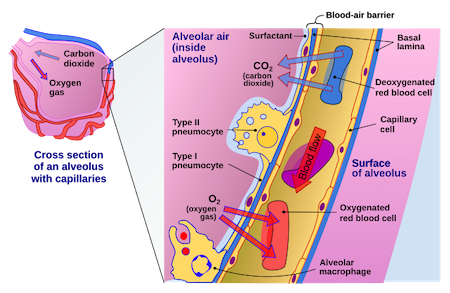
Measurement of Partial Pressure of Gases
Partial pressure is a critical concept in understanding gas exchange. It refers to the pressure exerted by an individual gas within a mixture of gases. The total pressure of a gas mixture is the sum of the partial pressures of all its components, as described by Dalton’s Law. This law states that:
(P_total = P_1 + P_2 + P_3 + …)
In the context of respiration:
- Atmospheric air primarily consists of nitrogen (78%), oxygen (21%), and trace amounts of carbon dioxide and other gases.
- At sea level, atmospheric pressure is approximately 760 mmHg. Therefore, the partial pressure of oxygen (PO2) in dry air can be calculated as: PO2 = 0.21 × 760 = 159.6 mmHg
However, when air enters the respiratory system, it becomes humidified with water vapor, reducing PO2. In alveolar air, PO2 is approximately 104 mmHg due to continuous oxygen diffusion into blood and carbon dioxide diffusion out.
The measurement of partial pressures is essential because gases move along their partial pressure gradients, from areas of higher partial pressure to lower partial pressure. For example:
- Oxygen diffuses from alveoli (PO2 ≈ 104 mmHg) into pulmonary capillaries (PO2 ≈ 40 mmHg).- Carbon dioxide diffuses in the opposite direction due to its higher partial pressure in venous blood (PCO2 ≈ 45 mmHg) compared to alveolar air (PCO2 ≈ 40 mmHg).
Factors Affecting the Rate of Gas Diffusion
The rate at which gases diffuse across membranes is governed by Fick’s Law, which states:
(Rate = (A × D × ΔP) / T)
Where:
- A: Surface area available for diffusion.
- D: Diffusion coefficient (depends on solubility and molecular weight).
- ΔP: Partial pressure gradient across the membrane.
- T: Thickness of the membrane.
Key factors influencing gas diffusion include:
- Partial Pressure Gradient:
- A larger difference in partial pressures between two regions increases diffusion rates.
- For oxygen: The gradient between alveolar air (104 mmHg) and deoxygenated blood (40 mmHg) drives rapid oxygen uptake.
- For carbon dioxide: Despite a smaller gradient (~5 mmHg), CO₂ diffuses efficiently due to its high solubility.
- Surface Area for Diffusion:
- The lungs provide an enormous surface area (~70 m²) through millions of alveoli.
- Diseases like emphysema reduce this surface area by destroying alveolar walls, impairing gas exchange.
- Membrane Thickness:
- The thinner the respiratory membrane (~0.5 µm), the faster gases diffuse.
- Conditions like pulmonary fibrosis or edema increase membrane thickness, slowing diffusion.
- Solubility and Molecular Weight:
- According to Graham’s Law: Lighter gases diffuse faster than heavier ones under identical conditions.
- However, CO₂ diffuses ~20 times faster than O₂ because it is much more soluble in blood plasma.
- Ventilation-Perfusion Matching:
- Efficient gas exchange requires proper matching between ventilation (airflow) and perfusion (blood flow). Imbalances can occur due to blockages or diseases.
Respiratory Membrane Through Which Gases Diffuse
The respiratory membrane is where external respiration occurs—oxygen enters blood while carbon dioxide exits into alveoli. It consists of several thin layers that facilitate efficient gas exchange:
- Alveolar epithelium (a single layer of squamous cells).
- Thin interstitial space containing tissue fluid.
- Capillary endothelium lining pulmonary capillaries.
- Plasma within capillaries.
- Red blood cell membranes where oxygen binds to hemoglobin.
The total thickness of this barrier is only about 0.5 µm, making it highly efficient for diffusion.
Summary
Gas exchange relies on physical principles such as Dalton’s Law and Fick’s Law to explain how oxygen and carbon dioxide move across membranes based on their partial pressures and other factors like solubility and surface area availability. The respiratory membrane provides an optimized structure for this process through its thinness and large surface area for diffusion efficiency.







